PUPPY TIMELINE
Puppy breath to teenage terror to reliable adult.. This page is a timeline of the growth and development of a Doberman Pinscher. The next page Owner Preparation is a list of what owners need to have prepared while they're waiting for their bundle of joy!
Mating, Pregnancy, Gestation, & Whelp
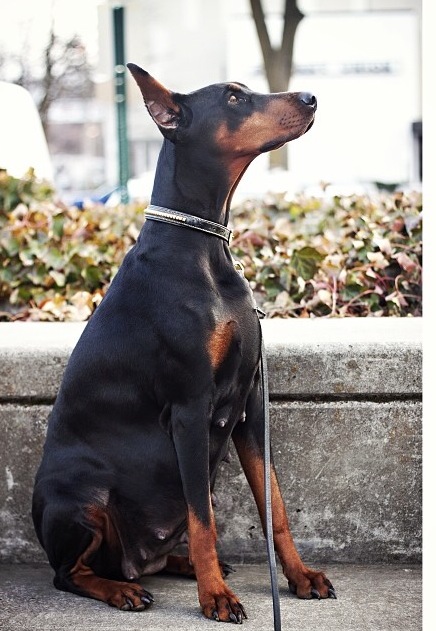




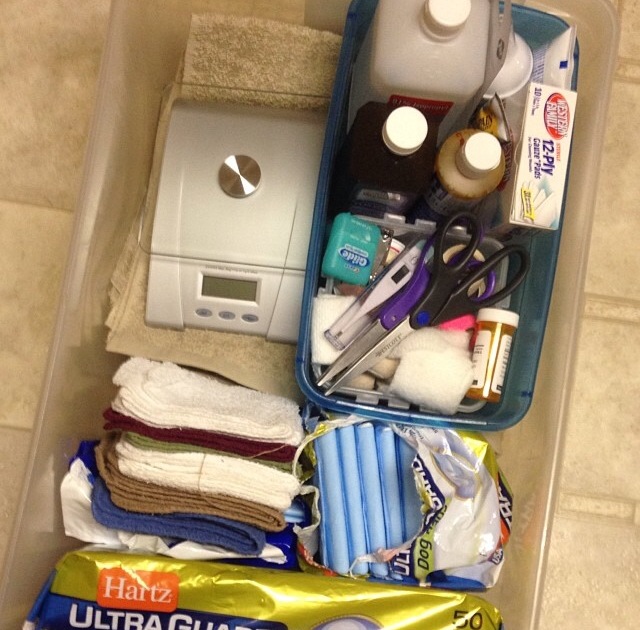







Bitches come in heat twice a year, approximately 6mos apart. The breeder will have a rough estimate when the heat cycle is expected and plan the breeding around that time. Some females are more predictable then others. The heat cycle lasts about a month. Mating is carefully planned around hormone testing involving progesterone and/or thyroid tests which will indicate when ovulation occurs.
The breeder will mark their calendar for approximate due date 62-63 days from the day of the first and last mating. At approximately 30 days an ultrasound to confirm pregnancy may be available. Over the next weeks she will gain weight and begin to show, appetite increase, and frequency of urination will increase too. It is important to keep the mommy dog comfortable, well fed, and as little stress as possible. She should start sleeping and resting in her whelping box at this time so that she feels accustomed to it.
The puppies' bones will not be calcified enough to show up on an X-ray until day 55. At that time it is ideal for the breeder to have an X-ray taken so that they know approximately how many puppies to count for at birth (whelp) and if any are a risk in size/positioning.
The week of the due date the breeder will be watching 24/7, have all the whelping supplies on hand, and vet on call just in case. They will take her temperature every day that last week, and getting closer to the due date taking the temperature multiple times a day. It is not confirmed by formal scientific research but most breeders can use a drop in temperature as a fairly reliable indication that labor is coming. Normal dog's temperature is about 101.5, due to hormone levels the mommy dog will usually have a temp around 100 in the last trimester of pregnancy. When the breeder notices a drop to 98 degrees or lower, labor should start in 24hrs or less.
Whelping (birth) could start at any time of the day, but often at the most inconvenient hour. Signs of labor: pacing, dilated pupils, digging/burrowing/nesting, hiding in secluded/dark areas, panting, etc. The breeder will watch for these signs and when they begin will confine her to the whelping box area. It is handy to have a notebook and pen in the whelping area so that all activity can be recorded, including exactly what time each puppy comes. If any problems arise it will help the vet greatly to know where she is at. She will have contractions, they are visible in the abdominal area. The breeder should interfere as little as possible so that the "full mommy instincts" can kick in, but be prepared to assist as needed.
Puppies may be born with or without the sac, they need stimulated and mouth/nostrils cleared right away so that they start breathing. The mom will lick them lots and if she does a good job with the umbilical cord then the breeder should allow her to. Some moms need a little more assistance or are too rough with the cord so need the breeder to do it for them. Puppies can come quickly depending on contractions or they may take up to three hours in-between. If it is a large litter of 10 or more puppies (common for Dobermans), this could be a very long process! The breeder will watch to make sure each puppy is cleaned and nestled in, sex/color/markings/weight etc may be identified and recorded and each puppy marked with a colored ribbon collar. Having a puppy warming box is helpful to keep them cozy but separate from mom while she starts contractions and the next puppy arrives - that way they don't get squished if she moves around a lot and so they can stay cleaner. They will need to nurse every hour or two and as soon as they can nurse after birth the better, so the breeder will rotate them all and gather them back up before the next puppy is born usually.
Congratulations! The puppies are all born and mom and pups are safe and well. Of course we all want pictures/video/news but both breeder and mom are exhausted by this point, some rest and bonding time is in order. Some moms are more concerned and protective over their babies, while others readily accept the breeder to handle/remove puppies at will. It is important to keep watch over them all for the next critical 3-5 days making sure there is plenty of nutrition to mom and babies and warmth. There should not be any visitors yet and handling of the puppies kept at a minimum just to check weights/vitality.
Newborn
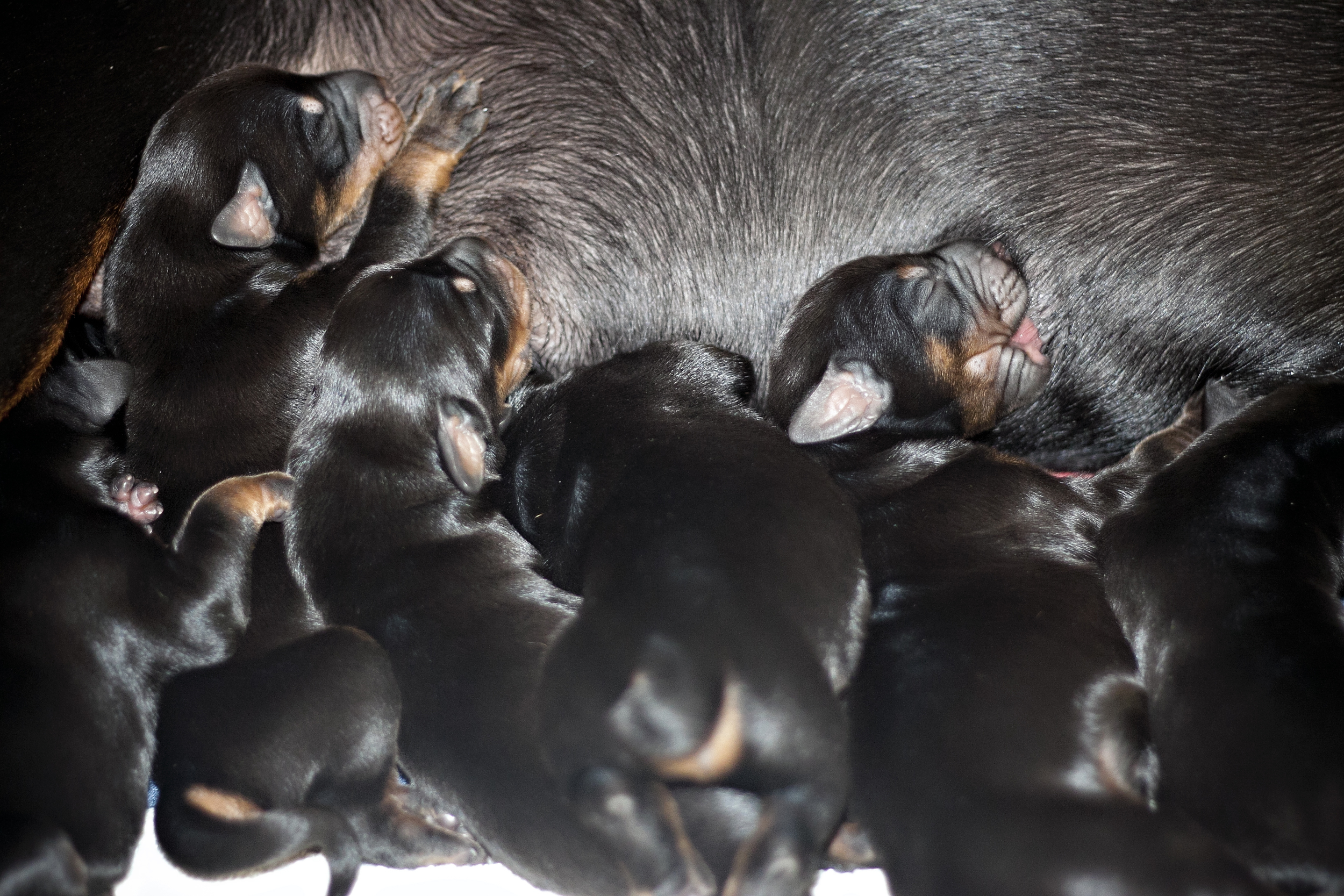




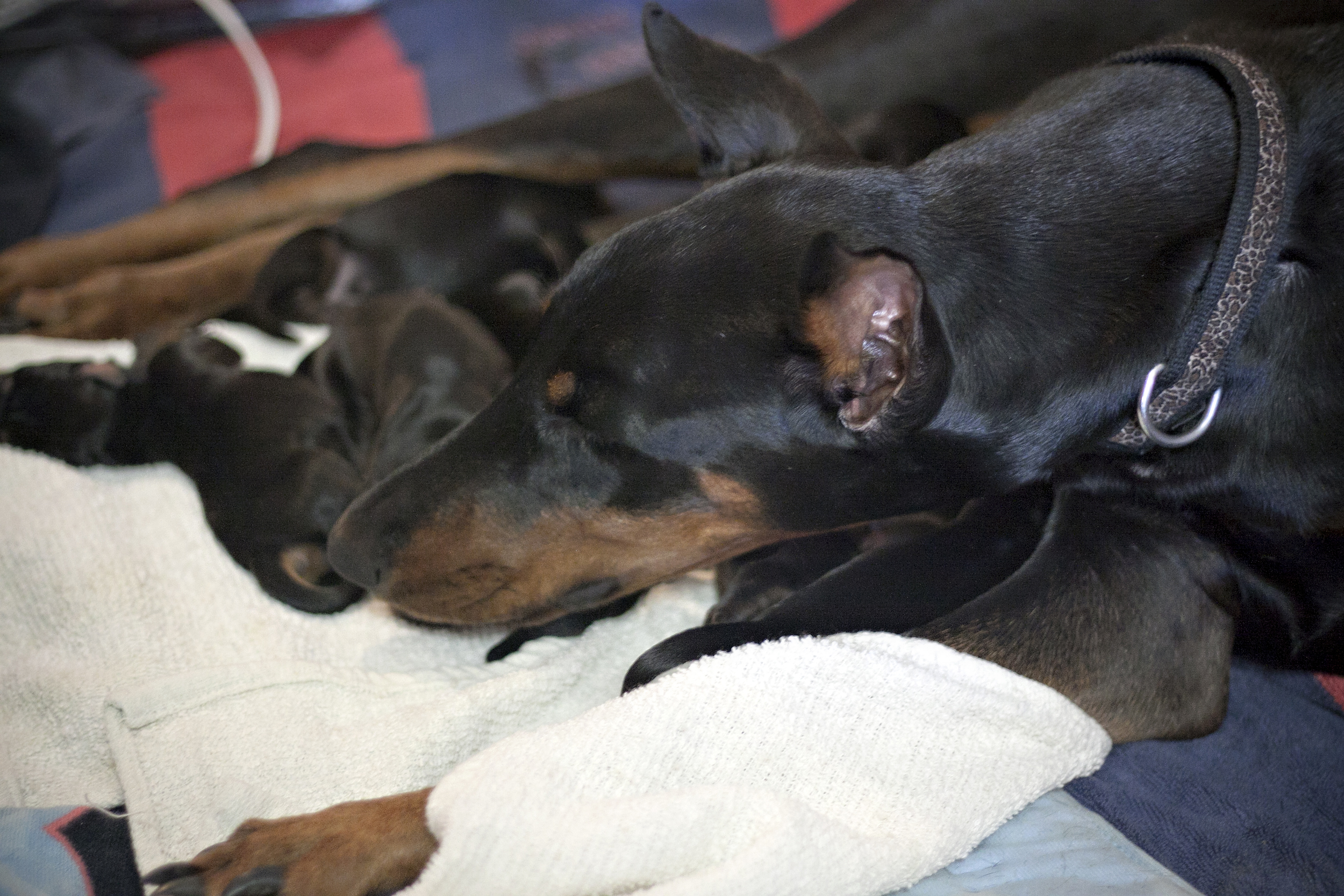






A newborn Doberman puppy weighs on average between 10-20oz. They are born with eyes shut and ears tightly shut too. They have dewclaws on their feet, flopping ears, and long tails - I think it looks like an "otter pup" with the tail! They nurse a tiny bit every one to two hours and grow very quickly at this stage. Between 3-5 days old the vet will dock the tails at the second vertebrae and stitch it up, and the tiny dewclaws are removed and closed with surgical glue.
Week 1






Not a whole lot has changed from birth but they do weigh a little more and can squirm around pretty good to find the best nursing. They are palm sized and can fit in your hand. The breeder should be interacting with them a lot from here on out, it is called "imprinting" when they handle the puppies from early age to get them used to human touch.
Week 2






By this time the eyes start to open, it will take awhile too for the ears to open up. They are just bigger than your hand, weighing a couple pounds by now usually. They can push up on their legs and almost "stand." This is the age when most breeders start the first set of deworming for mom and puppies.
Week 3


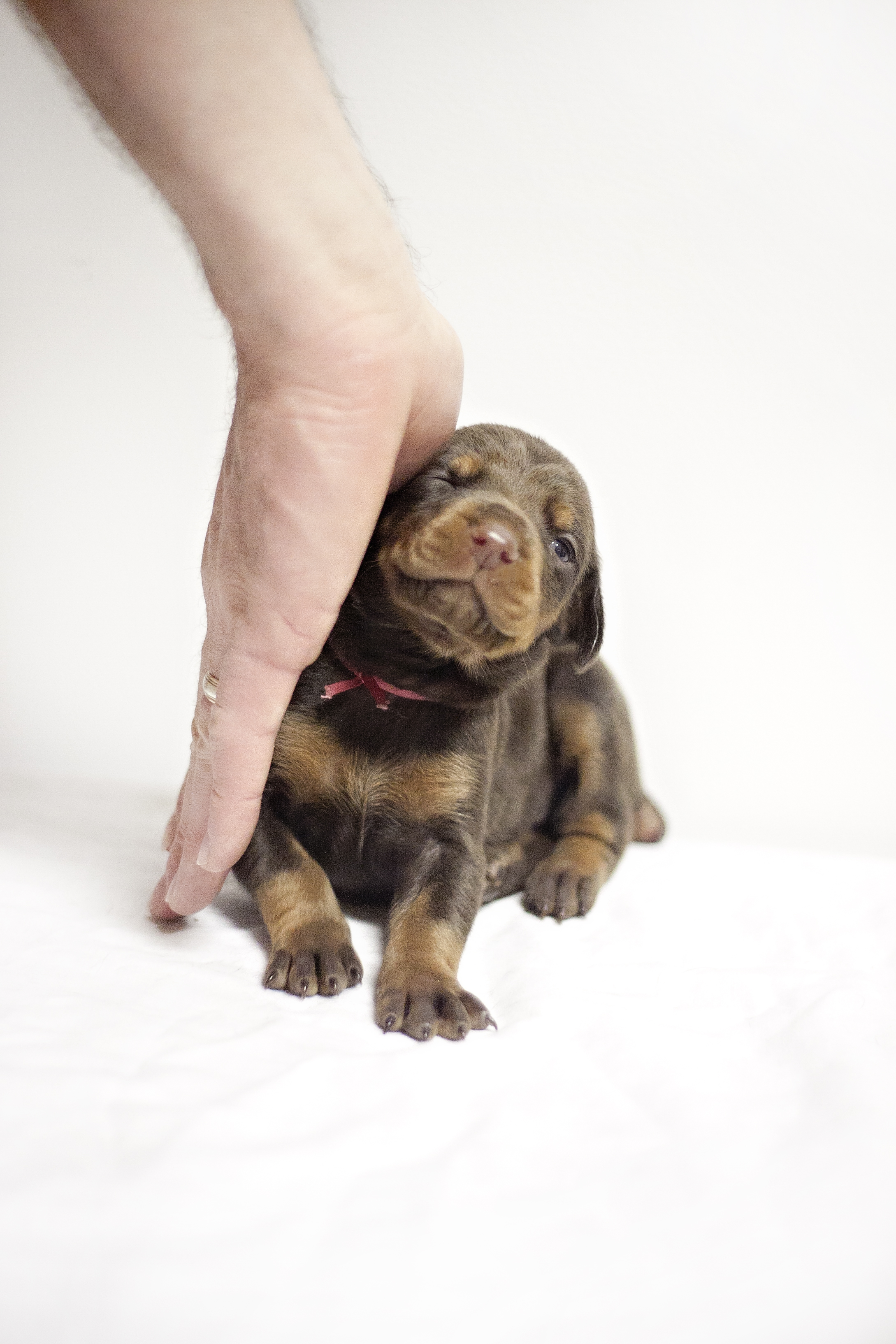
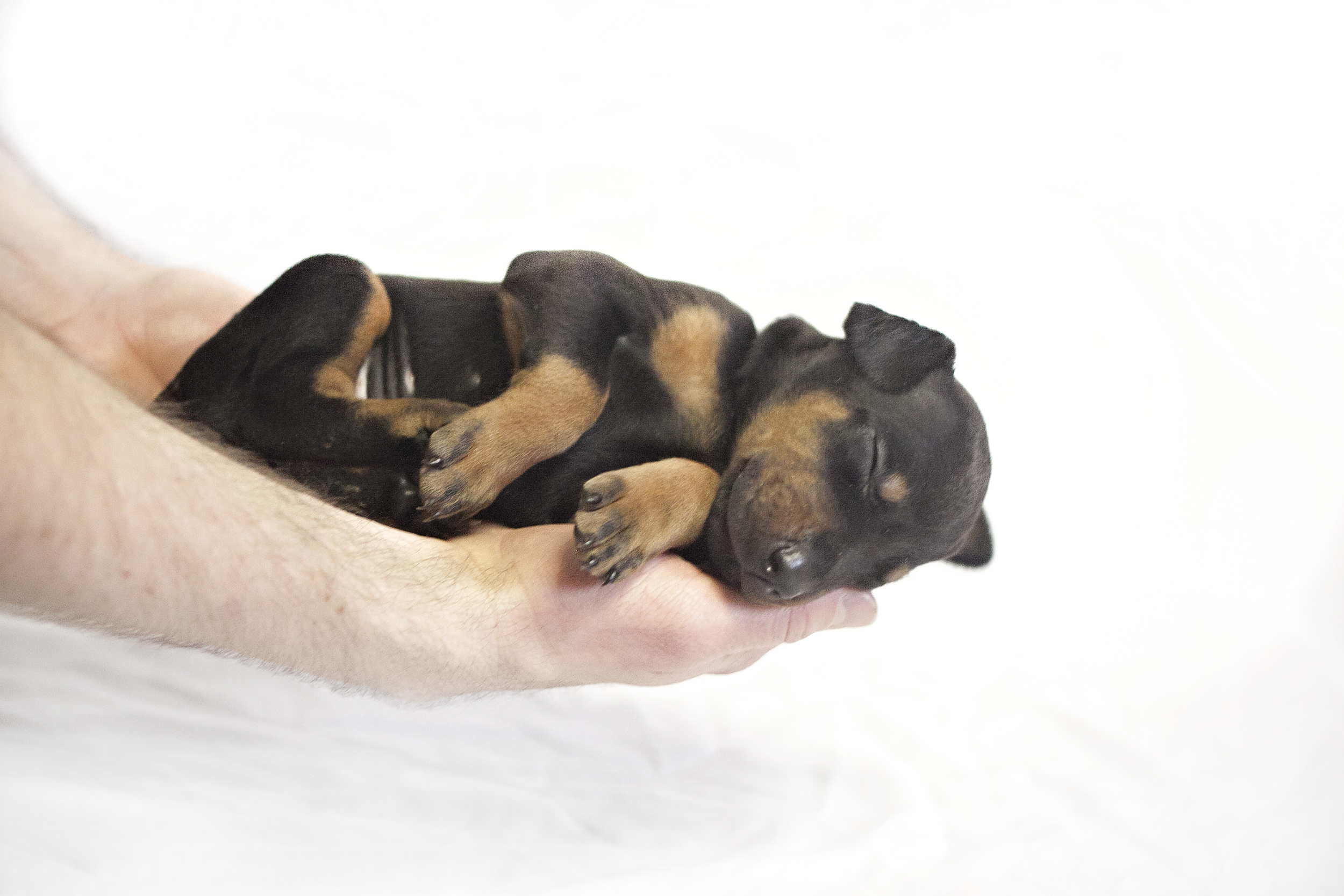

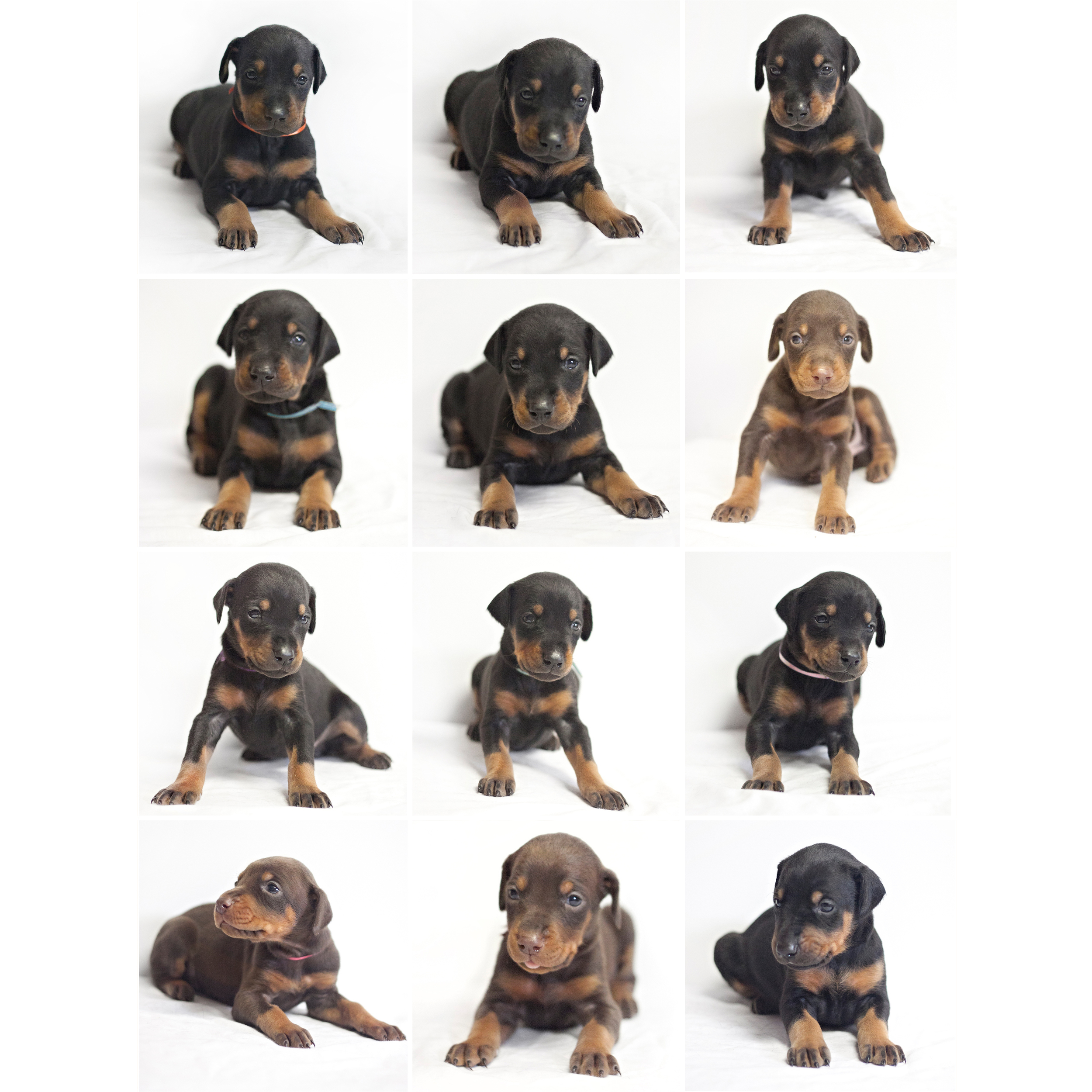


This age they are now gaining mobility and can scoot/crawl around. They are gaining better vision and can recognize when mom is near. They are starting to get curious and explore, but still mostly sleeping/eating only.
Week 4

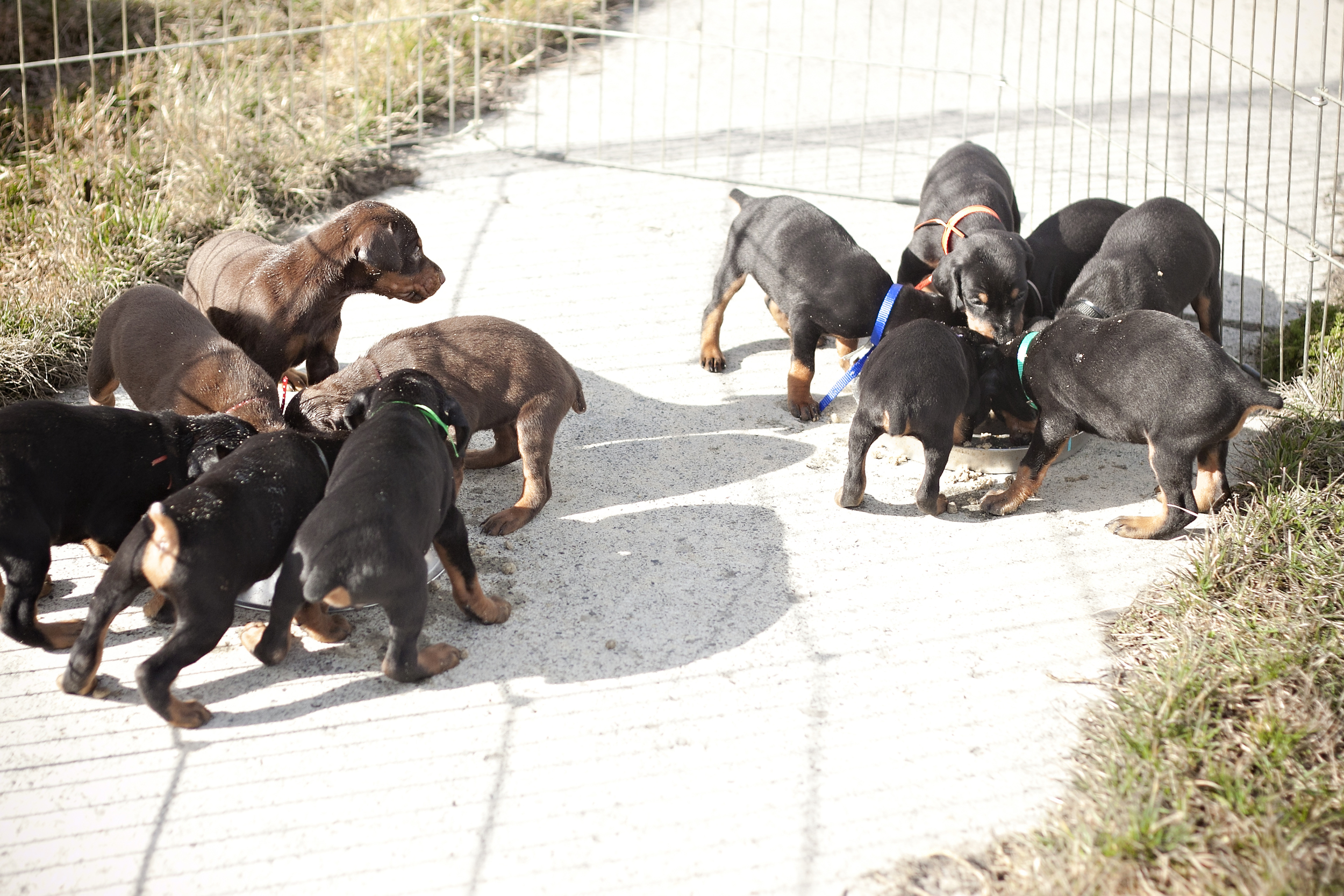
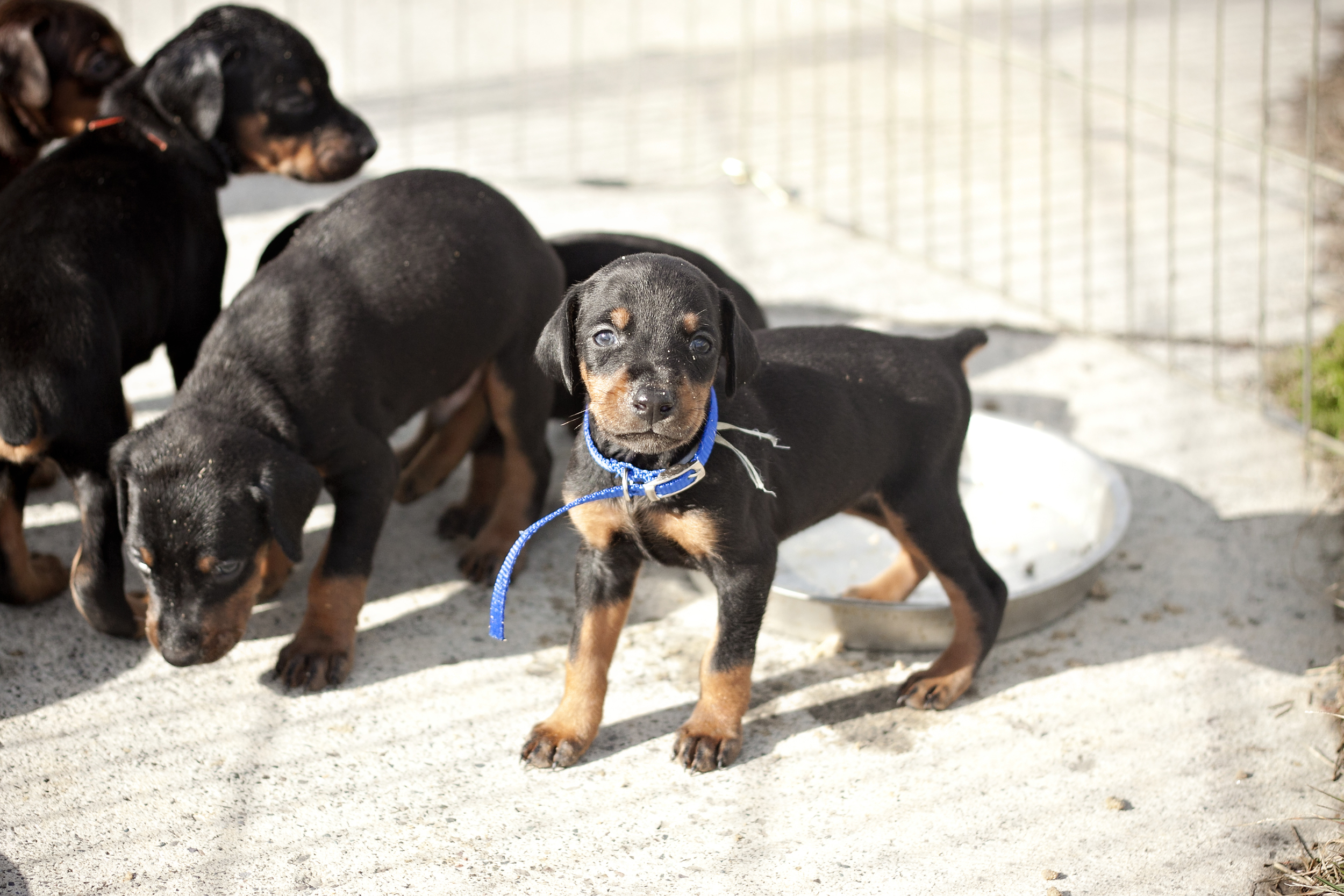

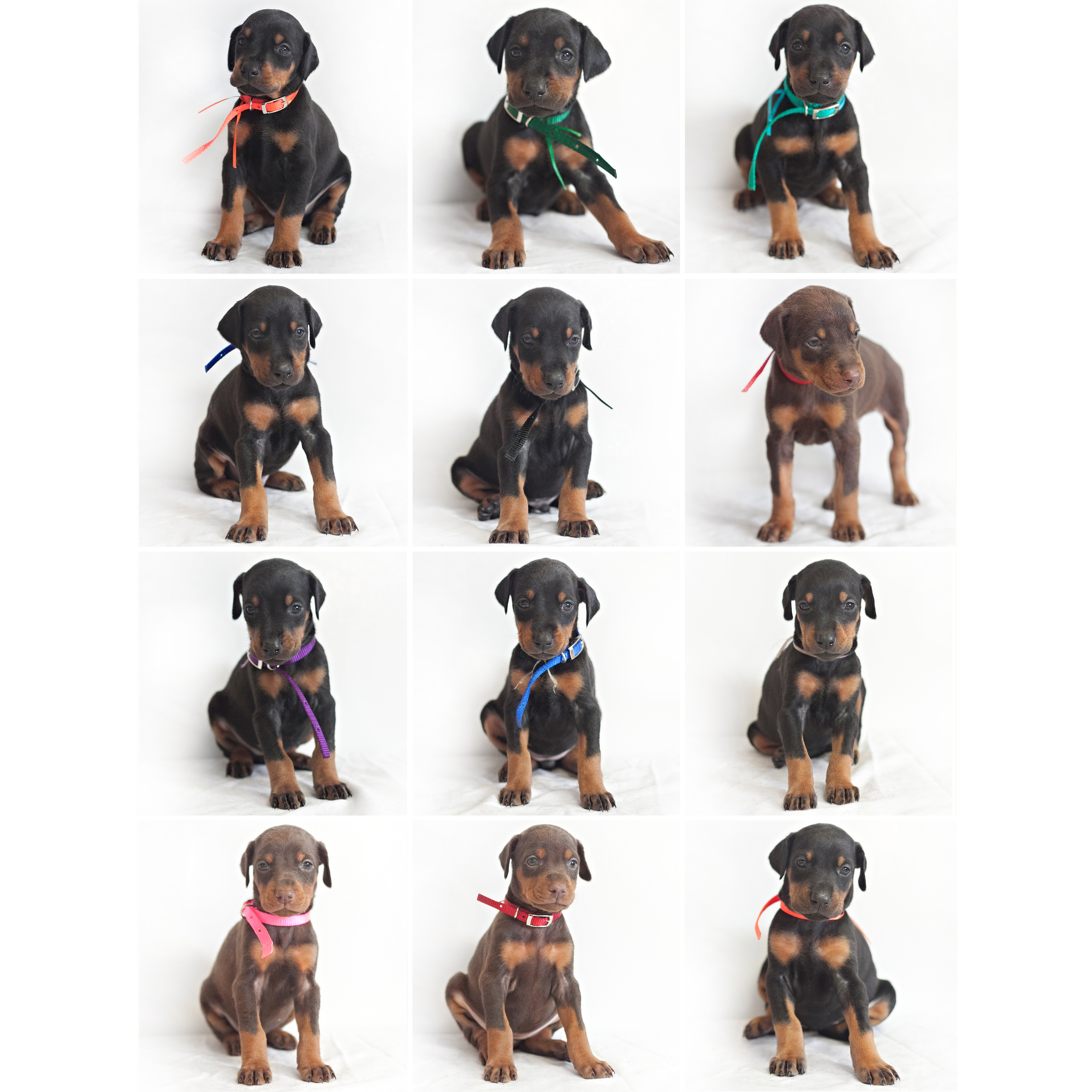



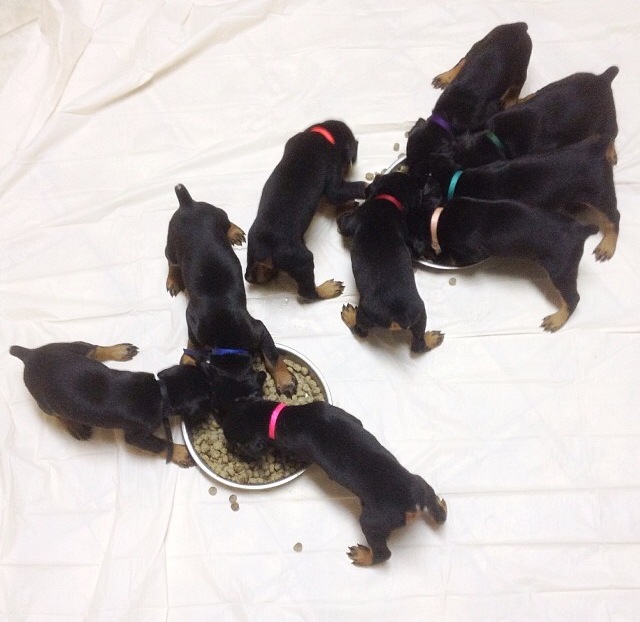

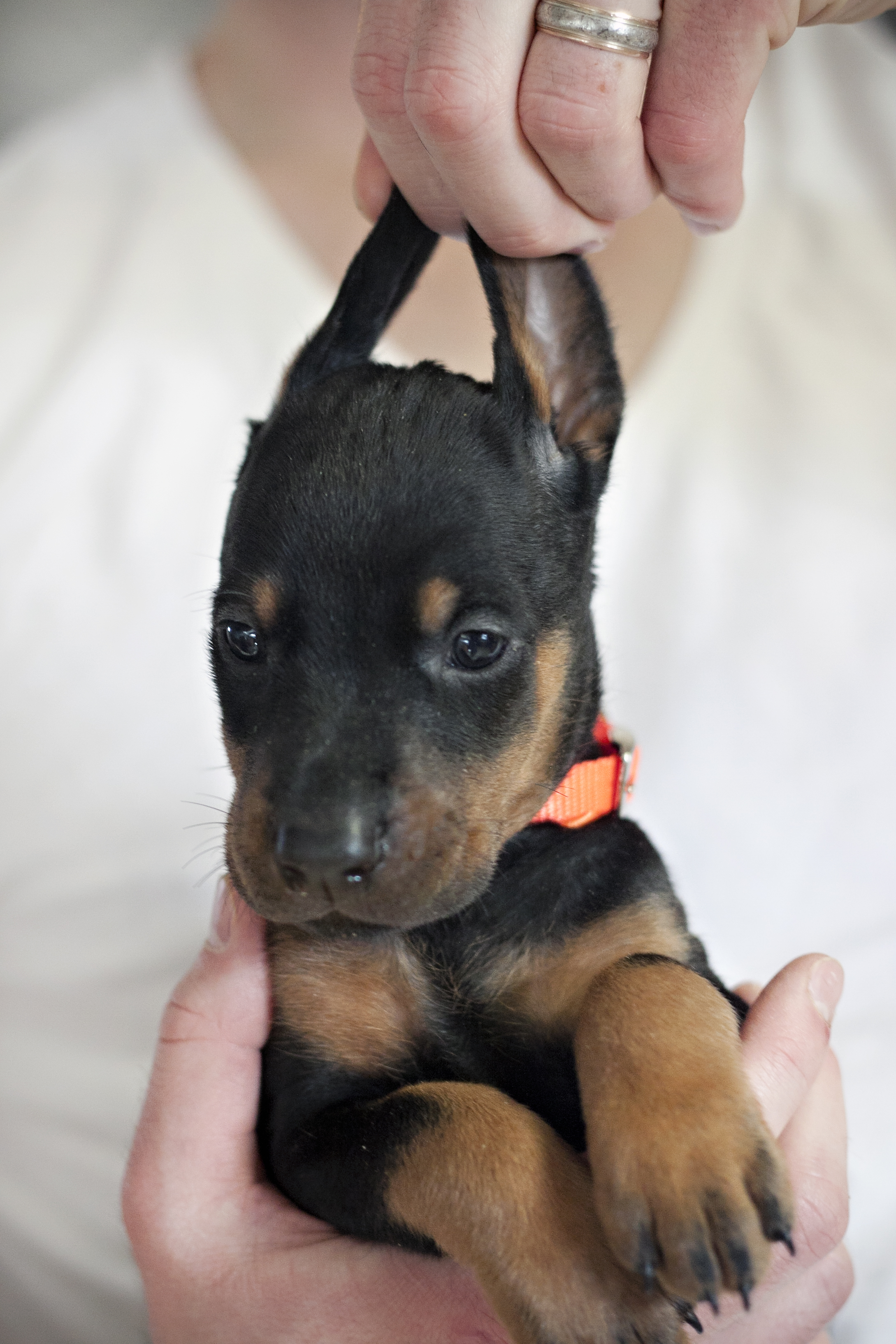

The personalities are starting to show as they learn to walk and start to play a little with each other and their surroundings. Mom may start tapering off their nursing in preparation to be weaned. The breeder will introduce them to feedings now. A large pan of milk (puppy formula)/water soaked dog food is placed on the floor a few times a day and they are encouraged to try some. Also water dishes are put out for them to start drinking water on their own too. To this point mom has helped them poop and pee and cleaned it up but they are now doing it all on their own, the breeder has to step in and clean much more. Second dose of deworming for the puppies at this time as well.
Week 5








The puppies are quite mobile and getting more interactive. Some toys and new objects are placed in the whelping box and they come out for play time during the day. They are being weaned by the mom in this stage so she may only come to check on them and nurse once or twice during the day, but is still usually staying through the night. They are eating their "mush" and drinking water. Weather permitting, they will start their first adventures outside and getting to see the world around them.
Week 6


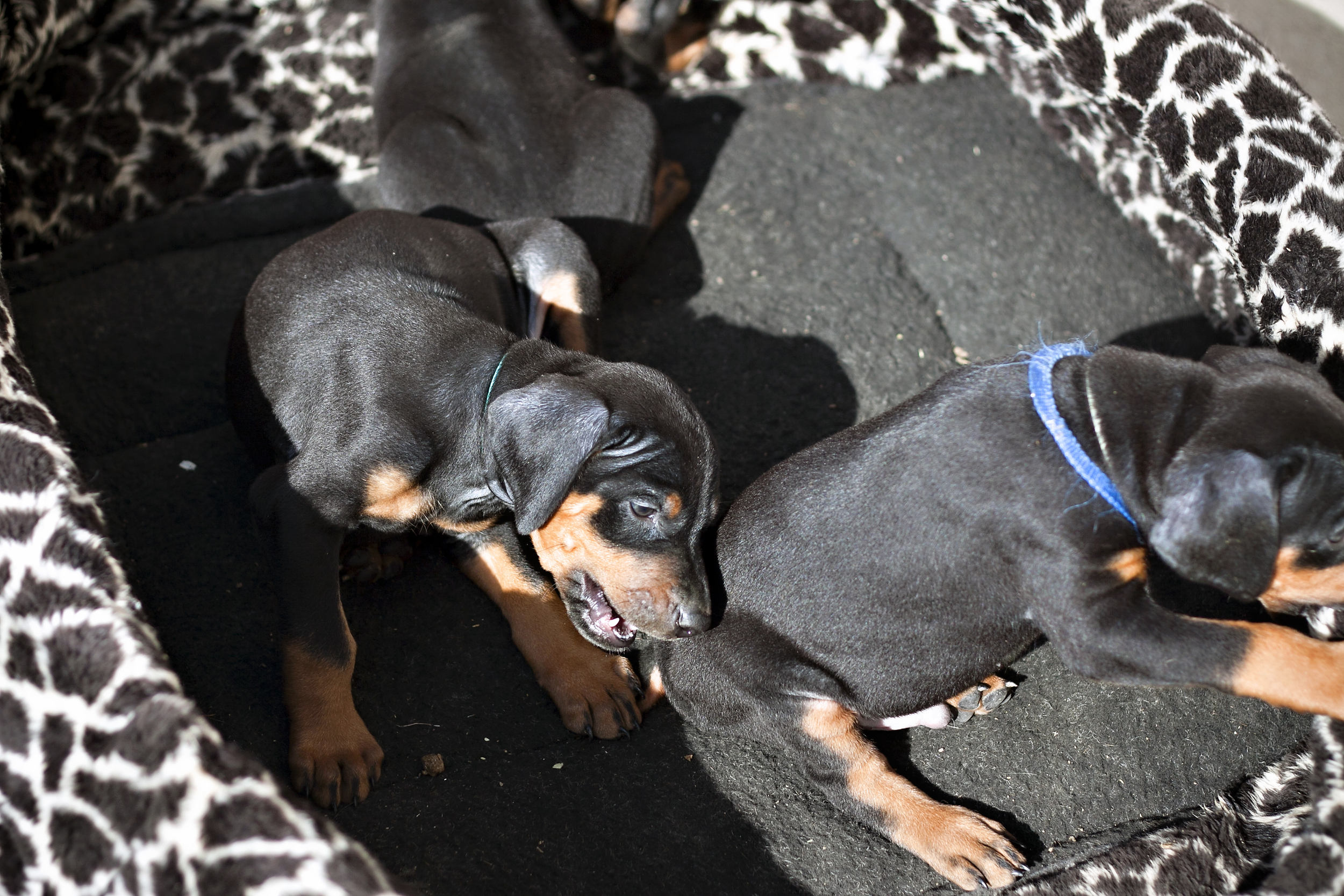









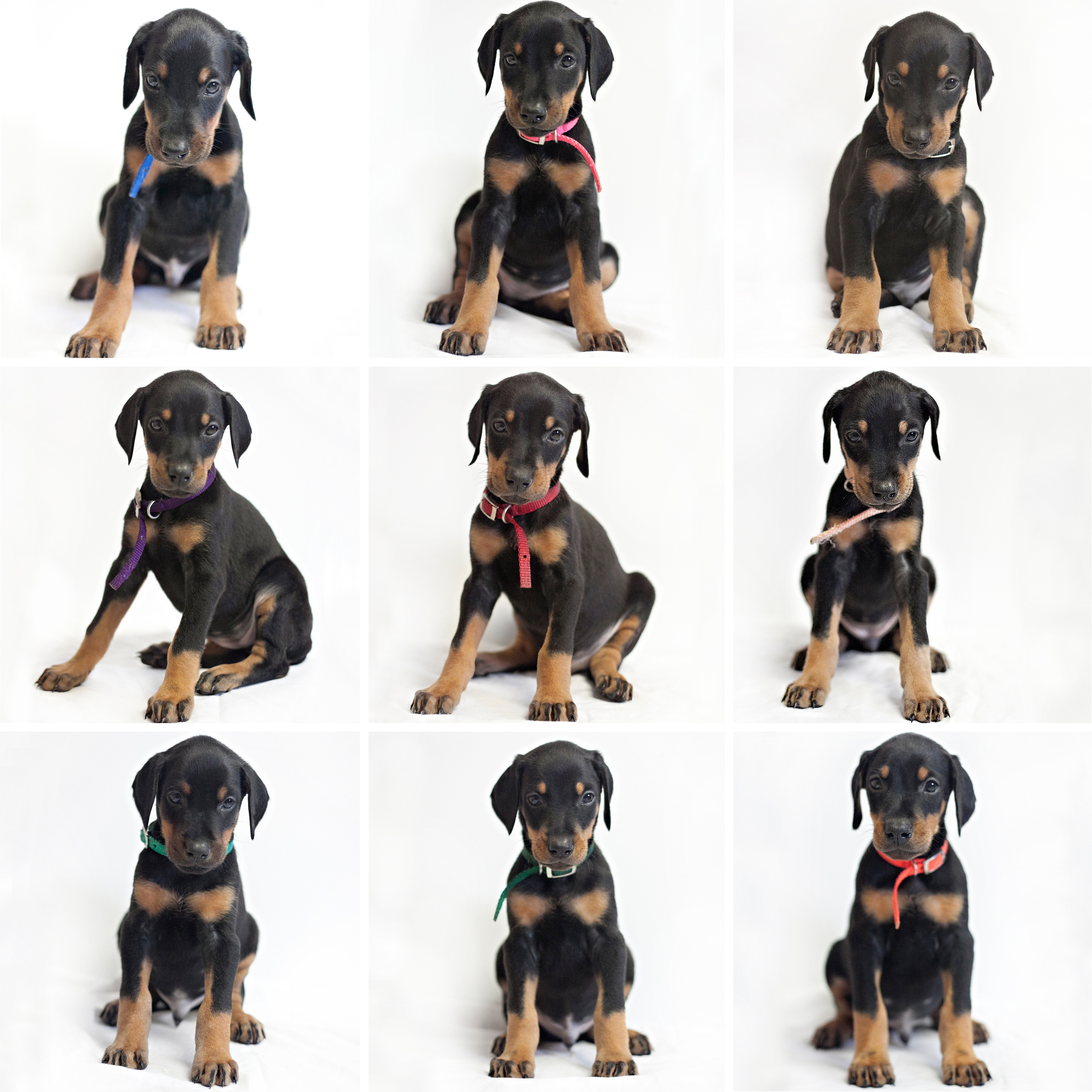
This week the puppies are fully weaned and eating food and drinking water all on their own several times a day. Most 6 week old Doberman puppies weigh around 8lbs now. They are now becoming quite needy for attention and interaction. They play, tussle, run, and hop about. At night they will wake and cry because they are just getting used to the new schedule of not having mom around for night feedings. A "babysitter dog" may step in throughout the day to interact with the puppies but who does not tolerate nursing advances, so that the puppies learn not to nurse on adult dogs anymore and also for socialization. They have their first vaccine as well, along with another deworming dose.
Week 7







Week 7 is when the breeder will do formal temperament evaluations, such as the Volhard Puppy Aptitude Test. Each puppy is individually evaluated and then the notes and observations from the breeder compiled from the last 7 weeks. This will help determine personality and working aptitude for placement in their future families.
Week 8


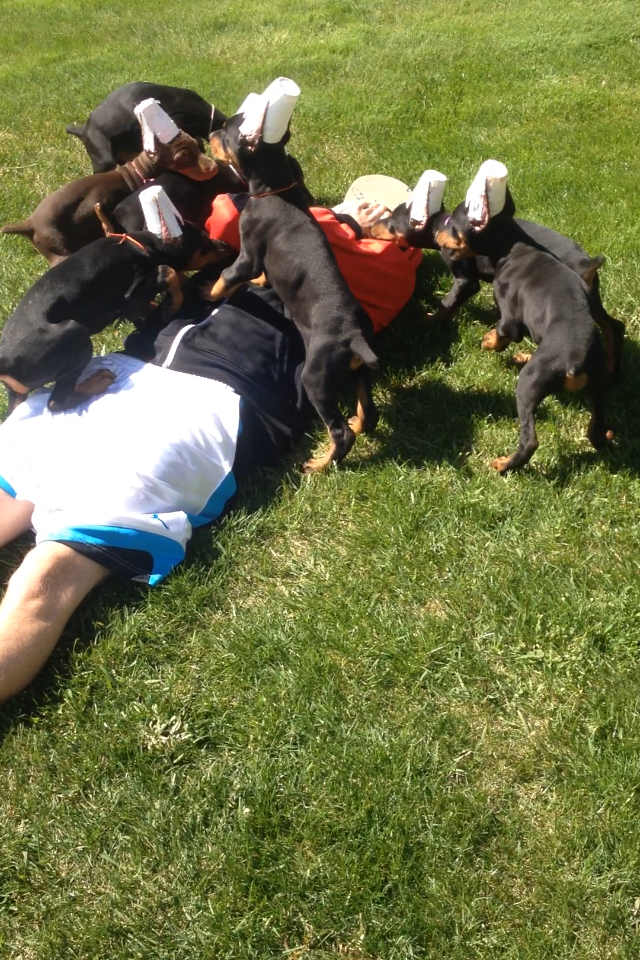






Week 8 is when the breeder will do a formal physical or conformation evaluation. This will help determine which puppies may have show potential and placement in their future families. They have their second vaccine and should weigh at least 10lbs for surgery, but most likely will be 12-20lbs.
Between 7-9 weeks they will have their ear crop scheduled, usually after each puppy has been designated to the best fitting home, that way the breeder knows which ones will have a show crop and which will have medium/pet crop.
Week 9 - Six Months Old
After 8 weeks old and after their ears are cropped, your puppy is ready to go home to you! This may be between 8-10 weeks (up to 12 weeks for puppies not placed yet) of age depending on what is arranged with you and the breeder. By this point they are eating, drinking, running, playing, etc and all are all ready for a home of just their own. They have gone in car rides, to the vet, outside and inside on different footings, had interaction with breeder's friends/helpers to socialize them, lots of toys, a bath as needed, and some crate exposure. Basic obedience, potty training, and crate training begin!
The first few nights puppy will cry. It is his/her first time all on their own! Read more about training in the TRAINING article, but it is important to know when to comfort them and when to let them "cry it out." They will need lots of supervision so they don't get into mischief, and lots of attention. Puppy will start learning their new name right away. They will bond very quickly and become attached to their new family. They will need to eat at least three meals a day and go outside frequently for bathroom. There will be ear care required to re-post the tapes on the ears about every 3-5 days (or immediately if they come loose or get wet) for several weeks to come.
There will be a couple more vaccines required including the rabies vaccine at 12 weeks or older. Do not take them to public places (especially pet stores/parks/areas where other dogs have been) until the vaccine set is complete, otherwise they risk getting sick, even fatally sick.
The household routine and rules they start to get the hang of. Teething, when they loose their baby teeth and the adult teeth grow in, starts and they will want to chew. Provide acceptable chew toys and appropriately redirect when/if they go after something not desirable. You will probably find "little shark teeth" around the house.
By 6 months old they will have most if not all the adult teeth in, the ears will be standing or very close to (unless they have a longer crop), and they will be eating two meals a day, sleeping through the night, potty trained, and starting on their obedience. At this age it is very important to enroll them in socializing/obedience classes. Even if you are very experienced in training dogs, the puppy really needs the public interaction and exposure. Since they are fully vaccinated and immune system in good condition by this point, they are ready to go to class and on as many public outings as possible. Be careful when you introduce them to other dogs and people. Some puppies may need slow introduction. They should be confident and eager, but take care with the ones who need a little reassurance. You do not want to push your puppy into anything they are frightened or uncomfortable with. If you do, they will lose trust and security in you. Encourage and reward them for venturing out. Be extra careful when introducing to other dogs or animals. If the other dog/animal reacts unexpectedly and growls/bites/lunges toward your puppy, it could be a life scarring and traumatic experience. Just keep close eye and stay near so you can pick them up if needed. Puppy class is a safe environment and the instructor will monitor the interactions with you and also help with any questions on the upbringing and development of your puppy.
Seven Months - 1 Year Old
The next several months your puppy will continue to grow and mature. Females are near their adult full height and will continue to fill out over the next year. Males will grow and mature over the next year not reaching full height until 18mos approx.
They are mature and old enough "technically" for spay/neuter by now, discuss with the breeder and your veterinarian what is best in your dog's individual case. Spay/neuter is a "hot topic" of debate. We have gone well out of our way to read medically based research papers and statistics and to discuss with vets, other breeders, and specialists at the University. From my research I can only conclude that it must be on individual basis, it would not be healthy or ideal to spay/neuter prior to 6mos of age, and that as long as the behavior is manageable and there is no risk for accidental matings/pregnancies - let them develop as long as they can even up til 12-18mos of age if it is possible. If mating/pregnancy is a risk, or hormonal behavior becomes a problem, have them fixed sooner rather than later. Keep in mind females will have their first heat cycle usually between 6-8mos but many and for larger size (Dobermans included) it is more like 8-12mos of age. There are pros and cons to the decision so discuss with the breeder and your veterinarian.
1 Year Old and on..
Happy Birthday! One year old is a special milestone, your puppy is now considered an "adult." They still have some physical and mental maturing. Enjoy the "prime years" of your dog. They may participate in show/working/performance venues and keep up with their family in all the activities. They will become very reliable and loyal companions. They will love and always desire to be near you and they will protect you. Make sure you give your Doberman plenty of attention and exercise, good vet care, quality food, fresh water, toys and mental games like training or tricks.
At age two they may complete their health screenings. Each year thereafter requiring the annual updates. If the dog may be bred, this is a must. If the dog is a companion only, consider if you will do some/all of these tests so that you are fully aware of your Doberman's health. (see HEALTH page)
At seven years old, by show standards they are in the "Veteran class." They might slow down a little physically, but usually stay young in heart and spirit. Heart problems and cancer are a concern for the aging Doberman. The average Doberman lifespan is 10 years old. Cherish your years with those graying faces!
